
ACT Science Practice Test 8
Đề thi nằm trong bộ sưu tập: Tuyển Tập Bộ Đề Thi Đại Học Hoa Kỳ (ACT) - Có Đáp Án Chi Tiết
Số câu hỏi: 24 câuSố mã đề: 1 đềThời gian: 1 giờ
218,495 lượt xem 16,802 lượt làm bài
Xem trước nội dung:
Sylvatic, or jungle, Yellow Fever is caused by a virus transmitted by mosquitoes from monkeys to humans. Figure 1 shows the life cycle of the mosquitoes who carry this disease. These mosquitoes' eggs do not hatch unless there is enough water for the next two stages of their life cycles. Yellow Fever is passed when an adult of these mosquitoes first bites a monkey that is infected with the virus and then bites a human.
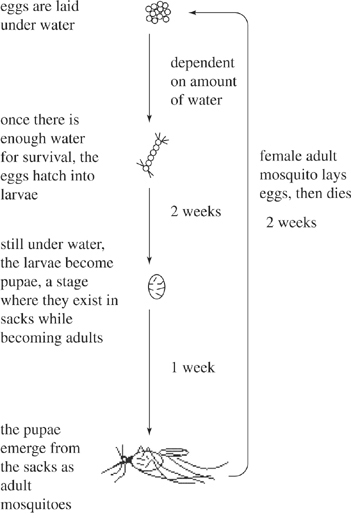
Figure 1
A study was done on a group of ecologists who went into a jungle where the monkeys carrying the Yellow Fever virus live. These ecologists were divided into groups based on how frequently they went into the jungle. The ecologists were tested monthly for Yellow Fever. Figure 2 shows the number of new cases of Yellow Fever and the amount of rainfall in the jungle. For each group, Table 1 shows the number of ecologists in each group, number of mosquito bites, and percent of each group with Yellow Fever.
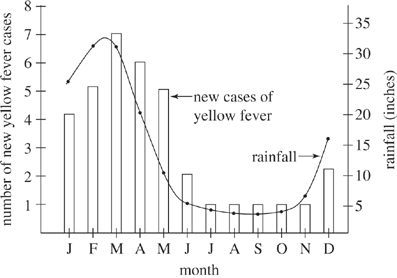
Figure 2

Based on Figure 1, what is essential in maintaining the mosquito population?
Jungle
Water
Monkeys
Humans
Based on Table 1, the average percent of ecologists affected by the yellow fever virus was closest to:
20%.
30%.
60%.
80%.
Suppose additional data had been gathered for Table 1 about the number of mosquito bites per month. Based on Figure 2 and Table 1, in which of the following months would you expect to have the largest total of mosquito bites per month?
April
June
August
November
According to Figure 2, the amount of rainfall was different for each of the following pairs of months EXCEPT:
May and December.
February and March.
January and October.
April and May.
Based on Table 1, as the number of trips into the jungle increased, the number of monkeys seen:
increased only.
decreased only.
increased, then decreased.
varied with no consistency.
Ethanolamines are compounds that contain both alcohol (-OH or HO-) and amine (-NH3, -RNH2, -R2NH, or -R3N) subgroups. They remove weakly acidic gases from the atmosphere of enclosed spaces such as on a submarine. An example is the use of monoethanolamine (MEA) to remove CO2 from the atmosphere as shown in Figure 1.
2 MEA(liquid) + CO2(gas)  (MEA)COO-(aqueous) + (MEA)H +(aqueous) + heat
(MEA)COO-(aqueous) + (MEA)H +(aqueous) + heat
Figure 1
If the temperature rises sufficiently, ethanolamines will release any absorbed acidic gases back into the environment, creating a potential hazard.
Scientists studied the absorption properties of 2 ethanolamines (MEA and DEA).
Experiment 1
At 0°C and 1 atmosphere (atm) pressure, 1 mole (6.02 × 1023 molecules) of MEA was spread at the base of a reaction vessel containing CO2 gas at a concentration of 1,000 parts per million (ppm). As the CO2 was absorbed, its ambient concentration decreased. The scrub time (time for CO2 concentration to drop to at least 10 ppm) was measured. Longer scrub times indicate a slower rate of absorption. The experimental procedure was repeated at varying temperatures and for DEA, with results recorded in Table 1.
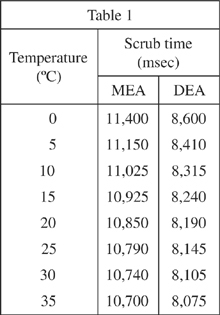
Experiment 2
The scrub times of MEA for different acidic gases were measured using the procedures of Experiment 1 at 26°C (see Table 2). Each of the gases listed is toxic and poses a significant safety hazard if its concentration becomes elevated within an enclosed space.
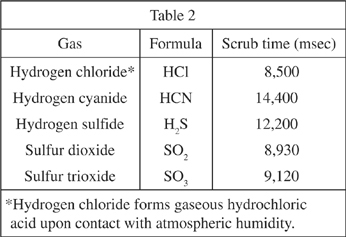
In which of the following ways was the procedure of Experiment 2 different from that of Experiment 1? In Experiment 2:
temperature was varied; in Experiment 1, the temperature was held constant.
temperature was held constant; in Experiment 1, the temperature was varied.
only MEA was used; in Experiment 1, only DEA was used.
only DEA was used; in Experiment 1, only MEA was used.
In Experiment 1, during the DEA trial at 20°C, as the time progressed from 0 to 8,190 msec, the concentration of CO2 in the vessel:
increased from 10 ppm to 1,000 ppm.
increased from 1,000 ppm to 10 ppm.
decreased from 10 ppm to 1,000 ppm.
decreased from 1,000 ppm to 10 ppm.
If, in Experiment 1, an additional trial were done at 12°C, the scrub times (in msec) for MEA and DEA would most likely be closest to which of the following?
10,805
10,985
11,000
11,025
Based on the information in the passage, which of the following is a possible chemical formula for an ethanolamine?
HO--(CH223
HO--(CH2223
H3243
H3223
A scientist claims that under the same conditions, DEA will always absorb CO2 at a faster rate than will MEA. Do the results of Experiment 1 support this claim?
No; at all temperatures tested, the scrub time for DEA was more than that for ME
No; at all temperatures tested, the scrub time for MEA was more than that for DE
Yes; at all temperatures tested, the scrub time for DEA was more than that for ME
Yes; at all temperatures tested, the scrub time for MEA was more than that for DE
Based on the results of Experiment 2, which acidic gas had the slowest absorption by MEA at 26°C?
HCl
HCN
H2
SO2
Taraxicum, the common dandelion, can reproduce both through spreading seeds and through vegetative reproduction. To spread its seeds, the dandelion grows seed pods shaped like globes, in which the seeds are loosely attached to a central ball; each seed grows a parachute-like tuft that lets it travel long distances on the wind (or when blown upon by humans). In vegetative reproduction, a new dandelion stalk and leaves can grow up from an existing root system. Two students discuss the spread of dandelion populations.
Student 1
In Taraxicum, vegetative reproduction and seed distribution make up the only means of growing new plants. Each accounts for 50% of the growth of new dandelions.
Taraxicum grows throughout North America. In many places there is very little wind. Therefore, Taraxicum must have a non-wind-based means of spreading itself. While blowing dandelion seeds is a common pastime among humans, this human influence is very recent in evolutionary terms; it is very unlikely that Taraxicum evolved to rely on humans to distribute its seeds.
The way Taraxicum grows in a typical field shows that both vegetative reproduction and seed distribution are at work. While seeds scatter over the whole field, the dandelions tend to grow together in clumps. This suggests that individual seeds sprout the first new dandelions, which then grow several more through vegetative reproduction.
Student 2
Seed distribution is the main way Taraxicum spreads itself. Without seed distribution, there are very few new dandelions. Taraxicum does use vegetative reproduction, sending new stalks from existing roots, but this is mainly to replace the above-ground plant if it has been cut or eaten. This allows the plant to survive threats in the environment but does not allow for the growth of new plants.
Plant studies show that plants which rely on vegetative reproduction to spread themselves tend to have large, complex root networks or underground root clusters. Taraxicum plants, however, each have a single large, deep taproot. This makes them very difficult to uproot, but it also means that their roots do not spread out underground, so any new plants growing from the roots would compete with each other for sunlight. Even a slight breeze or the brush of a passing animal is enough to spread dandelion seeds to a new area. Additionally, all known types of Taraxicum produce seed globes. If half the new dandelions grew from vegetative reproduction, then a seedless dandelion should not be at a competitive disadvantage and should be commonly observed in the wild.
Experiment
The students proposed 3 trials using an introduced Taraxicum population in three fields in a windy area where Taraxicum can naturally thrive (see Table 1).

Suppose an experiment were performed in which several new Taraxicum plants were planted in a field with their roots in glass jars and with plastic bags over the flowers. Assuming that Student 1's hypothesis is correct, the number of new dandelions in the field would most likely be what percent of the number in a control field?
0%
25%
50%
100%
Which of the following trials most likely provided the control group in the students' experiment?
Trial 1, in which TaraxicumTaraxicum
Trial 1, in which TaraxicumTaraxicum
Trial 2, in which Taraxicum
Trial 3, in which specimens are planted in large glass jars in a field similar to that of Trial 1
Student 1 states that dandelions growing in clumps "suggests that individual seeds sprout the first new dandelions, which then grow several more through vegetative reproduction." Which of the following indicates why Student 2 believes this cannot be true? Student 2 says:
Student 2 would most likely agree with the statement that Taraxicum:
uses vegetative reproduction to compensate for windless environments.
improves its ability to survive by using vegetative reproduction to regenerate.
has evolved a dependency on humans to distribute its seeds.
tends to grow in clumps in fields to which it has spread itself.
With regard to the experiment described in the table, Students 1 and 2 would most likely agree that the increase in the Taraxicum population would be greatest in a field where:
neither plastic bags nor glass jars were used.
plastic bags were used, but not glass jars.
glass jars were used, but not plastic bags.
both plastic bags and glass jars were used.
Suppose Trial 3 of the experiment were performed as described. Based on Student 1's hypothesis, the resulting population would be closest to what percentage of a control population?
0%
25%
50%
100%
Suppose the 3 trials were performed as described. Student 2's hypothesis about the way Taraxicum reproduces would be best supported if the number of new dandelions fit which of the following patterns?
The field in Trial 3 had roughly the same number of dandelions as the field in Trial 1, both of which had fewer dandelions than the field in Trial 2.
The field in Trial 1 had more dandelions than the field in either Trial 2 or Trial 3, while the fields in Trials 2 and 3 had roughly equal numbers of dandelions.
The field in Trial 2 had fewer dandelions than the field in Trial 3, which had more dandelions than the field in Trial 1.
The field in Trial 3 had slightly fewer dandelions than the field in Trial 1, both of which had many more dandelions than the field in Trial 2.
Three studies were conducted to analyze the content of cake mix.
Study 1
Samples of 3 different cake mixes (X, Y, and Z) weighing 500.0 g were desiccated (thoroughly dried) in a 350°F oven for 36 hours and then passed through a sieve with 0.045 cm holes. Each sample was evenly spread in a trough 0.100 cm deep with a fan at one end and a secured piece of dark colored paper at the other end, downwind from the fan, as shown in Figure 1. Fan speed was slowly increased from 0 m/s until cake mix particles could be seen on the paper. This speed is called the maximum immovable speed. The maximum immovable speed was recorded for each sample.

Figure 1
This procedure was repeated with 35.0 g of cornmeal, a heavier ingredient, added to the cake mix prior to drying. The results are shown in Table 1.
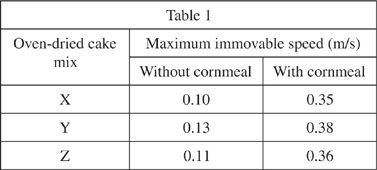
Study 2
Samples of each cake mix were prepared as in Study 1. Each sample was mixed with 500 mL of water then allowed to rest for 6 hours to ensure equal saturation of all particles in the sample. The samples were then evenly spread in a trough in an apparatus identical to that of Study 1. The fan was set to 10 m/s. Once the fan had dried the sample sufficiently, particles began to appear on the dark paper. At this point, the water content of the sample was calculated. This procedure was repeated with the 16 m/s fan speed. This set of procedures was then repeated with samples of each cake mix to which 35.0 g of cornmeal had been added. Figure 2 displays the results.
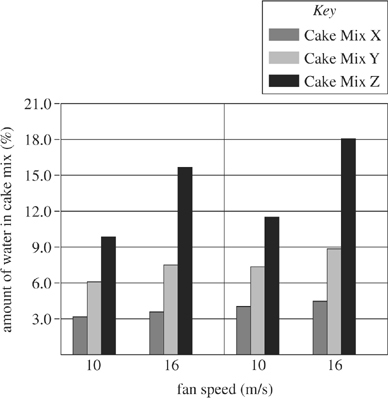
Figure 2
Study 3
Samples of each cake mix, without any preparation, were analyzed for flour particle, sugar particle, gelatin particle, and water content. The results are shown in Table 2.
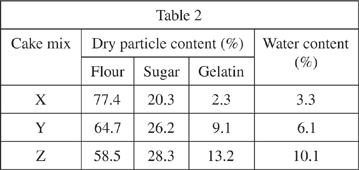
Based on Study 3, the water content of cake mix Z after being allowed the 6 hours to saturate with water in Study 2 was most likely:
greater than 10%.
between 6% and 10%.
between 1% and 6%.
less than 1%.
Which of the following statements about the maximum immovable speed in the trials without cornmeal is best supported by the results of Study 1 for the three cake mixes?
The maximum immovable speed for all cake mixes was 0 m/s.
The maximum immovable speeds for all cake mixes were roughly equal.
The maximum immovable speed for cake mix Y was three times the maximum immovable speed for cake mix
The maximum immovable speed for cake mix Y was half the maximum immovable speeds of cake mixes X and
Based on the results of Study 1 for a given cake mix, the addition of cornmeal to the cake mix caused a maximum immovable speed that was approximately:
half as high as the maximum immovable speed when no cornmeal was added to the cake mix.
twice as high as the maximum immovable speed when no cornmeal was added to the cake mix.
between two and two and a half times as high as the immovable speed when no cornmeal was added to the cake mix.
between two and a half and three and a half times as high as the immovable speed when no cornmeal was added to the cake mix.
If equal amounts of cake mixes Y and Z were blended and then prepared as in Study 1, then tested under the conditions of Study 1 with cornmeal added, the maximum immovable speed for this sample would most likely be:
between 0.23 m/s and 0.25 m/s.
between 0.28 m/s and 0.33 m/s.
between 0.36 m/s and 0.38 m/s.
between 0.39 m/s and 0.43 m/s.
A food scientist hypothesized that cake mixes with higher dry particle contents of gelatin will have a higher water content than cake mixes with lower dry particle contents of gelatin. Is this hypothesis supported by Study 3?
Yes, because as gelatin content of cake mixes X, Y, and Z increased, water content decreased.
Yes, because as gelatin content of cake mixes X, Y, and Z increased, water content increased.
No, because as gelatin content of cake mixes X, Y, and Z increased, water content decreased.
No, because as gelatin content of cake mixes X, Y, and Z increased, water content increased.
A fourth cake mix, cake mix Q, was analyzed as in Study 3. It was determined to contain 61% flour, 28% sugar, and 10% gelatin. Based on Study 3, what range would most likely be the water content of cake mix Q?
Less than 3.3%
Between 3.3% and 6.1%
Between 6.1% and 10.1%
Greater than 10.1%
